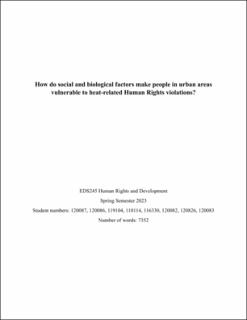| dc.description.abstract | Heatwaves increase with global warming, and pose a threat to people’s health, livelihoods, wellbeing and labor productivity. Higher temperatures puts pressure on urban infrastructures that are essential for providing services to uphold Human Rights. Defining and locating vulnerable groups is important to evaluate which policy measures should be employed to target the vulnerable groups, to reduce fatal effects of heatwaves and protect people’s Human Rights. In this report, we assess how social and biological factors make people in urban areas vulnerable to heat-related Human Rights violations, and we aim to evaluate different policies that can be applied and different actors’ responsibilities and possibilities to protect vulnerable groups. We conducted a literature review to define four vulnerable groups and find information about different ways the infrastructure in urban areas can help reduce the effect of heat waves. We also conducted an interview with KlimaSeniorinnen and understand the ways in which civil society can push their government to protect their rights. Governments should implement policies that arise from their Human Rights obligations to safely and adequately adapt to the impacts of climate change and extreme heat. The policies should especially target the vulnerable groups, by ensuring access to cooling centers and systems, which will also be beneficial for all of us. However, it is crucial to have sufficient and strict policies to reduce emissions, which can result in fewer cases of heatwaves and less extreme heat over time. Our findings can help policymakers in targeting vulnerable groups in their development policies in response to heatwaves and global warming, and motivate civil society to stand up for their Human Rights. | en_US |
